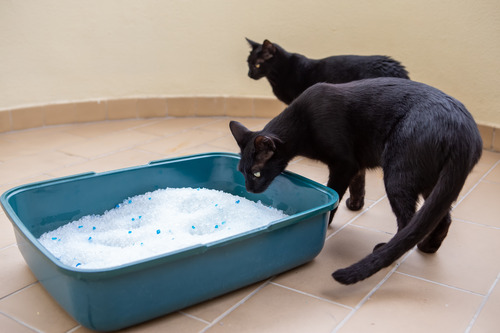If your cat is pooping outside the litterbox, you’re not alone—and it can be just as frustrating as it is puzzling. This behavior can leave you feeling overwhelmed and unsure of what’s causing it. The good news is that this problem usually stems from a few common issues that, once identified, can often be addressed. From medical concerns to changes in the home environment, understanding what’s behind your cat’s behavior is the first step to restoring litterbox habits. In this blog, we’ll explore the possible reasons your cat may be avoiding their litterbox and what actions you can take to support their return to better bathroom habits. For personalized guidance, reach out to the team at Creekside Pet Care Center in Keller, Texas by calling (817) 421-5850 or booking an appointment online today.
Medical Problems Can Trigger Litterbox Avoidance
Health issues are a common reason behind a cat pooping outside the litterbox. When a cat is experiencing pain or discomfort, they may associate that pain with the litterbox and begin avoiding it.
Common Medical Conditions to Consider
- Constipation, diarrhea, and inflammatory bowel disease (IBD) can cause discomfort during defecation. If your cat begins to associate the litterbox with pain, they may try to relieve themselves elsewhere.
- Parasites and food intolerances can also contribute to irregular bowel movements, making it more difficult for your cat to get to the litterbox in time.
- Urinary tract infections (UTIs) or arthritis may not directly affect bowel movements, but they can still lead to litterbox avoidance due to general discomfort or difficulty accessing the box.
- Cats with mobility issues might find it hard to climb into a high-sided box, which leads them to choose a more accessible location nearby.
If your cat has suddenly started pooping outside the litterbox, it’s worth scheduling an exam to rule out medical causes. The sooner a health concern is identified, the sooner your cat can begin to feel better.
Litterbox Setup May Be Causing the Issue
Even healthy cats will avoid the litterbox if they don’t like how it’s set up. Cats are particular animals, and something as simple as the type of litter or the location of the box can make a big difference.
Box Size and Accessibility
A litterbox that’s too small or difficult to enter might discourage your cat from using it. This is especially true for larger or older cats. Covered boxes can trap odors and feel too confined, which may cause some cats to avoid them altogether. Ideally, your cat should be able to turn around comfortably inside the box.
Litter Type and Cleanliness
Cats have strong preferences when it comes to litter. Some dislike scented litters, while others don’t like the texture of certain brands. Clumping litter is often preferred, but even that can vary from one cat to another. The box should be scooped at least once a day—many cats will refuse to use a box that isn’t clean.
Location, Location, Location
If the litterbox is placed in a high-traffic area, near loud appliances, or next to where your cat eats, they may avoid it. Cats prefer a quiet, private space to do their business. If you live in a multi-level home, there should be a litterbox on each level, especially if you have more than one cat.
Stress and Environmental Changes Affect Litter Habits
Stress is a powerful motivator in feline behavior. Cats are sensitive to changes in their environment, and stress can manifest in unexpected ways—including pooping outside the litterbox.
New Pets or Family Members
Introducing a new pet, baby, or roommate can be overwhelming for some cats. They may feel the need to establish territory or may feel insecure in their usual routines. This emotional disruption can lead to inconsistent litterbox use.
Moving or Renovations
Have you recently moved homes or begun renovations? Even subtle changes like new furniture or a rearranged room layout can unsettle your cat. It might take time for them to adjust to the new environment or feel safe enough to use their litterbox regularly.
Litterbox Competition Between Cats
If you have multiple cats, one might be bullying the other away from the box. Even subtle guarding behaviors can discourage another cat from using the litterbox. The general rule is to have one box per cat, plus one extra. Spacing them out throughout your home can help reduce tension.
Marking Behavior or Territorial Issues
In some cases, your cat may not be having a litterbox issue at all—it might be a form of marking behavior. While most marking is done with urine, fecal marking can occur, especially in multi-cat households or when a cat feels their territory is threatened.
Spotting the Difference Between Marking and Accidents
When a cat marks with feces, the stool is typically left in a highly visible area, often on a flat surface. Accidental pooping, on the other hand, tends to occur close to—but outside of—the litterbox. The consistency of the stool can also offer clues—normal, formed stool suggests marking, while loose stool may point to gastrointestinal distress.
Reducing Territorial Tension
Providing plenty of vertical space, hiding spots, and enrichment can reduce stress and help cats feel more secure. Make sure each cat has access to their own resources, including food, water, litterboxes, and rest areas. Pheromone diffusers may also support a calmer atmosphere in the home.
Aging and Cognitive Changes in Senior Cats
Older cats may poop outside the litterbox due to age-related conditions such as arthritis, cognitive dysfunction, or decreased mobility. These changes can make it harder for them to remember where the box is, reach it in time, or comfortably get in and out of it.
Adapting the Setup for Senior Cats
If your cat is entering their senior years, consider a litterbox with low sides and place it in a more accessible area. Avoid locations that require climbing stairs. In some cases, simply making the box easier to find and enter can resolve the issue. Keeping an eye on your senior cat’s habits can help you spot changes early and make adjustments before problems escalate.
When Is It Time to Consult Your Veterinarian?
If your cat continues pooping outside the litterbox, it’s important to consult your veterinarian at Creekside Pet Care Center. Behavioral issues are often linked to an underlying medical condition, and early intervention can make a difference. Your veterinarian can help identify or rule out any health problems and recommend next steps based on your cat’s individual needs. Even if a medical issue isn’t to blame, your vet can guide you toward practical strategies to encourage your cat back to using the litterbox consistently. Every cat is different, and finding the right solution may take time and patience.
Support Your Cat’s Litterbox Habits With the Right Resources
Resolving litterbox issues starts with understanding what’s driving the behavior. Whether it’s a medical concern, environmental stress, or an issue with the litterbox itself, your cat is trying to communicate something important. By observing their habits, making thoughtful changes, and seeking help when needed, you can support your cat in getting back on track. If your cat is pooping outside the litterbox, Creekside Pet Care Center in Keller, Texas is here to help. Our team can provide insight, recommend next steps, and partner with you to restore harmony at home. Call (817) 421-5850 or book an appointment online today.






